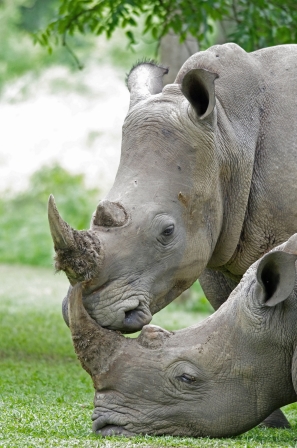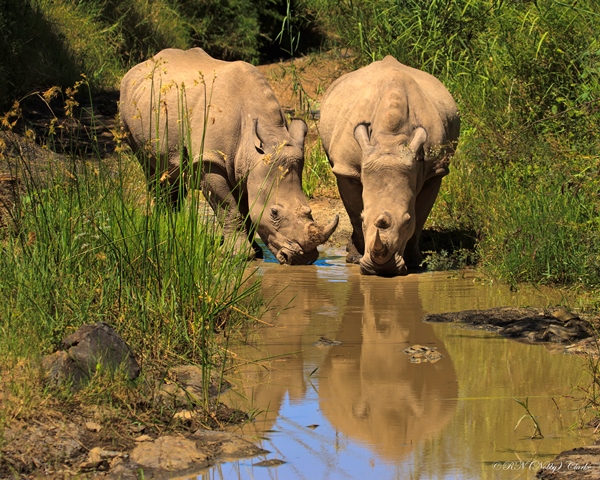World Rhino Day 2021 - Why They Matter
- Ayan Mehra
- Sep 22, 2021
- 4 min read
Covered from head to toe in leathery hide, a striking horn protruding from its ancient skull, the muscular, massive, and frighteningly swift rhino is one of the most majestic creatures in all the animal kingdom. Their appearance makes them seem like the last living dinosaurs. A relic from a previous world. However, at the rate at which the rhino population is declining, they won’t last very long… unless we do something.
My passion for conservation was first ignited in the summer of 2019 during my family's 2nd trip to Africa. We saw many fantastical creatures when we ventured into the wild, African bush. I particularly treasure one memory; as we turned the corner in our open jeep, we were immediately greeted by 3 lions, just meters away, feasting on the fresh carcass of a gazelle. We were so close in fact, that every time a lion would take a bite, we could hear the flesh being ripped and the bone being crushed. Africa was amazing, a place that I will hold close to my heart forever.
Though the animals were abundant and diverse, one animal eluded me. The rhino. We had seen a few rhinos scattered around the expansive savannah, but from so far away that they looked like rocks.
The main reason that rhinos are so scarce is because of illegal trafficking of rhino horn. Pound for pound, rhino horn is more expensive than gold. Though rhino horn has no proven health benefits, it continues to be used in some East-Asian traditional medicines/remedies. This medicine, called Muthi. Muthi, is made by grinding & mixing rhino horn with many other wild animal parts, to create a liquid that you can drink. This is thought to cure cancer and arthritis, along with many other health related issues. However, these beliefs are grossly misplaced as rhino horn is neither medicinal nor magical. Rhino horn is just keratin - the same thing as our fingernails!
With such high demand for rhino horn, some impoverished people in Africa are willing to risk long years of jail time, and sometimes even their own lives, to poach rhinos just to feed their family. Horrible things are being done to rhinos as a result of this, and their population in the wild has declined dramatically from 70000 in 1970, to just 27000 in 2021.
The solution to this crisis isn’t only to go after the poachers. This is a complex problem which needs a 2-pronged approach. On the one hand, we need to raise awareness in East-Asia that scientific evidence proves that rhino horn has no magical or medicinal properties. If people stop buying Muthi, then the demand for rhino horn will disappear, and that will help keep the animals safe. On the other hand, changing deep set beliefs on traditional medicine takes time. So, while we work on awareness building on what Muthi really is, we need to protect rhinos and other endangered animals in Africa from poachers, by supporting conservation efforts by the many public & private game parks and conservancies in Africa.
To this end, I started working with a private game reserve in South Africa called Thula Thula. They are located in the Kwazulu-Natal area, and are home to a wide variety of African wildlife including many elephants, rhinos, leopards, cape buffalos and now, even a cheetah. Thula Thula has a rhino family, and an orphanage for rhino, whose mothers have been victims of poaching. Often, a poacher will kill a rhino by tranquilizing (but not shooting) the animal, and then hacking the horn off while it is still alive. They do this, to avoid attracting the attention of rangers with the gunshots. If the rhino happens to be a female with a calf, the baby witnesses this horrific act of violence against its mother. Not only are these calves traumatized by what they see, but after the mother bleeds to death, they are very vulnerable in the wild without the protection of a parent. Hence, these wild orphans need human intervention to survive. I help Thula Thula by raising awareness and funding for wildlife conservation through art. The money raised from the sale of my wildlife-inspired sketches, postcards and gift tags, pays for the adoption of rhinos.
Rhino Art
Rhinos play a critical part in the natural ecosystem of the Bush. As megafauna, their role is to ensure that there isn’t an imbalance in the ratio of carnivore and herbivore populations. They do this by grazing sufficiently to prevent an overgrowth of grass, and thereby naturally curbing an excessive increase in the herbivore population.
While a lot has been done over the years, we still have a long way to go before we restore rhino populations to healthy levels. Indeed, in our lifetime itself, we will see the loss of the subspecies of rhino - the Northern White - as the last 2 surviving females live out their days in Ol Pejeta conservancy in Kenya. Unlike elephants, who evoke deep human empathy with their emotional intelligence and uncanny memories, the rhino often gets overlooked. I believe rhinos are a critical link to our natural history. They are a reminder of what the world looked like millions of years ago, when dinosaurs roamed the earth. And their story matters, just as much.
Rhinos at Thula Thula
































Ayan, thank you for this insightful piece. I had not realised that megafauna like the rhino are useful in controlling populations of other herbivores. We certainly want future generations to be able to experience rhinos like you have. May your campaigns go the distance in preventing megafauna extinction like that of the Mammoth in the northern hemisphere and the Diprotodon in Australia.